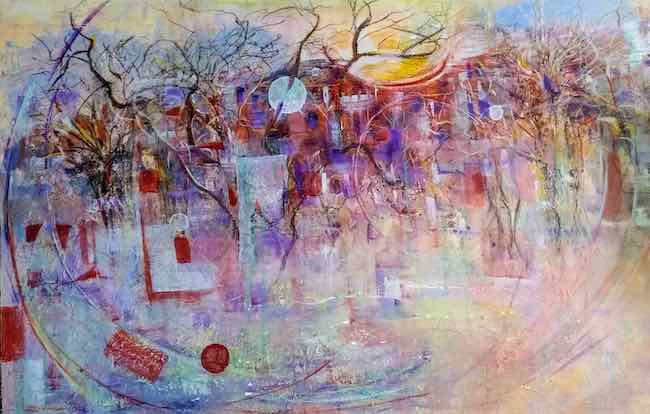Il mondo delle emozioni è un collegamento imprescindibile tra l’interno, il sentire profondo degli artisti come delle persone, e l’esterno, quell’universo conoscibile che interagisce inevitabilmente con l’individuo, a volte migliorandone le percezioni altre invece spostando l’attenzione del singolo su quelle complessità, ansie e angosce che appartengono al vivere contemporaneo. Ovviamente l’approccio pittorico e cromatico si adegua alla natura espressiva dell’esecutore dell’opera rivelando il suo sguardo sulla vita e la sua inclinazione osservativa e interpretativa su tutto ciò che gli ruota intorno. L’artista di cui vi racconterò oggi mostra una personalità positiva e aperta nei confronti del lato più armonico e piacevole della realtà.
Il mondo delle emozioni è stato per lungo tempo escluso dall’espressione artistica, poiché l’opera d’arte doveva prescindere dalla soggettività dell’autore e rappresentare nel modo più fedele possibile ciò che veniva colto dallo sguardo, nel caso del Realismo che contraddistinse gran parte dell’Ottocento, oppure raccontarne l’equilibrio estetico attraverso la narrazione della luminosità e la vivacità dei colori, nel caso dell’Impressionismo, e poi, qualche anno dopo, l’affermarsi dell’Astrattismo sottolineò la supremazia dell’arte su qualsiasi riferimento all’osservato o alle sensazioni dell’artista. Eppure, altri movimenti a cavallo tra fine Ottocento e inizi Novecento, imposero con forza l’esigenza di lasciar fluire le emozioni o le riflessioni sull’essenza della vita, mettendo la soggettività dell’artista e dell’essere umano al centro della ricerca pittorica; l’Espressionismo da un lato e il Surrealismo dall’altro, si distinsero proprio per la caratteristica di raccontare, rappresentare, le debolezze, le ansie e le emozioni dell’uomo dell’epoca, un periodo complesso in cui i venti di guerra eliminarono tutte le certezze mettendo in evidenza la caratteristica effimera della stessa vita. Per intensificare e dare maggiore rilievo al mondo emotivo che a quel punto doveva essere distaccato dall’immagine conosciuta per favorire una maggiore apertura e libertà di manifestazione delle sensazioni, Jackson Pollock fondò negli Stati Uniti intorno agli anni cinquanta del Novecento una corrente che prese il nome di Espressionismo Astratto, in cui vennero fuse le tematiche astrattiste, dunque il rifiuto dell’osservato perché distraente nei confronti della purezza e immediatezza delle emozioni, e quelle espressioniste dove il mondo interiore doveva essere prioritario su qualsiasi regola esecutiva, prediligendo la disarmonia e l’irrealtà cromatica affinché le opere potessero mettere in risalto l’universo interiore degli artisti aderenti al movimento. Nell’Espressionismo Astratto l’unica linea guida era la libertà espressiva finalizzata a lasciar fuoriuscire le sensazioni a volte più impetuose e irruente, tipiche del Dripping e dell’Action Painting di Pollock, altre più meditative e suggestive, come nel Color Field di Mark Rothko e di Helen Frankenthaler, o più minimaliste come nella pittura segnica di Franz Kline e di Robert Motherwell o nella quasi totale monocromia di Ad Reinhard.
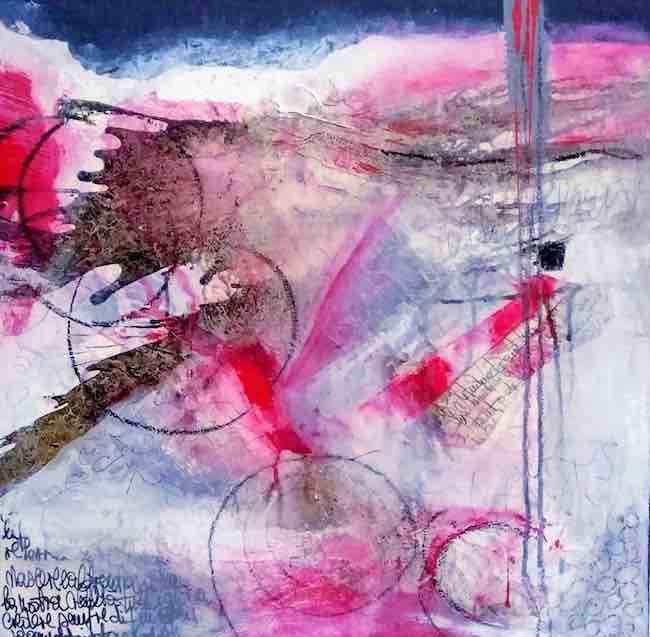
L’artista bolzanina Laura Lodi, dopo un lungo percorso all’interno dell’arte figurativa decide di avvicinarsi all’Espressionismo Astratto, in qualche modo ponendosi come linea di congiunzione con l’Astrattismo lirico fondato da Vassily Kandinsky perché le sue opere rivelano sempre un approccio melodico, armonico, predisposto all’ascolto di tutte quelle energie che fuoriescono dalla realtà che la circonda e che in virtù della sensibilità dell’artista riescono a trovare manifestazione, un canale di ascolto e di interpretazione che raggiunge l’osservatore in maniera delicata eppure chiara.
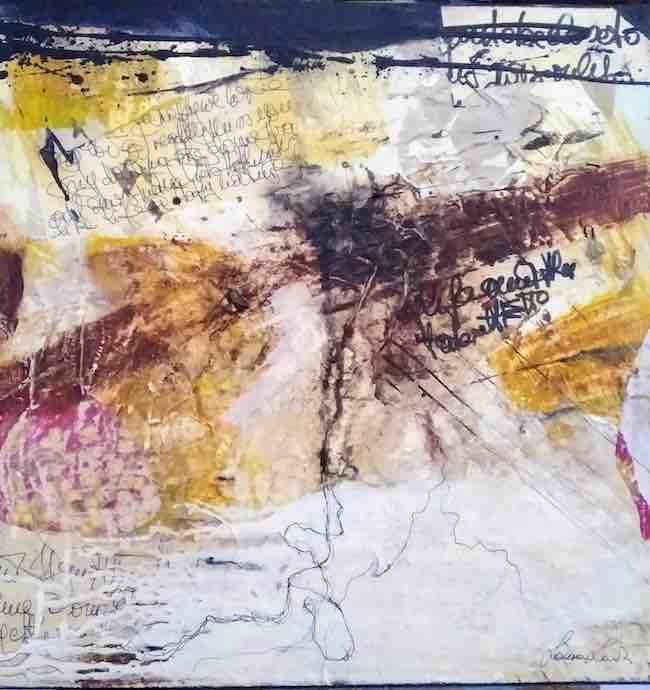
Ciò che colpisce delle tele della Lodi, oltre all’immancabile segno grafico che le definisce e che ne enfatizza il messaggio, è la gamma cromatica sempre vitale, positiva, orientata a osservare il lato bello e piacevole della vita intorno a lei, l’armonia percepibile solo attraverso un atteggiamento aperto e sorridente a tutto ciò che accade e si verifica, come se l’artista fosse consapevole che è volgendo lo sguardo verso la semplicità e l’immediatezza del sentire che si può prendere il meglio degli accadimenti, delle naturali riflessioni che si concretizzano in immagini indefinite ma piene di luce. Perché in fondo, sembra suggerire la Lodi, non è necessario aggrapparsi a ciò che l’occhio conosce per lasciarsi avvolgere dalle sensazioni che ne derivano e che possono essere descritte in maniera più intensa e coinvolgente proprio in virtù di un caos espressivo che attraverso la scelta dei colori giunge a mettere ordine comunicativo. Le tonalità scelte sono delicate oppure più intense ma sempre giocate sui toni dell’anima, i rosa, o dell’immaginazione e del sogno, gli azzurri, o ancora più variegate ma tese a infondere nell’osservatore un senso melodico, come se una musica immaginaria fosse parte integrante della tela e le emozioni fossero prese per mano per essere condotte all’interno del mondo sognante di Laura Lodi.
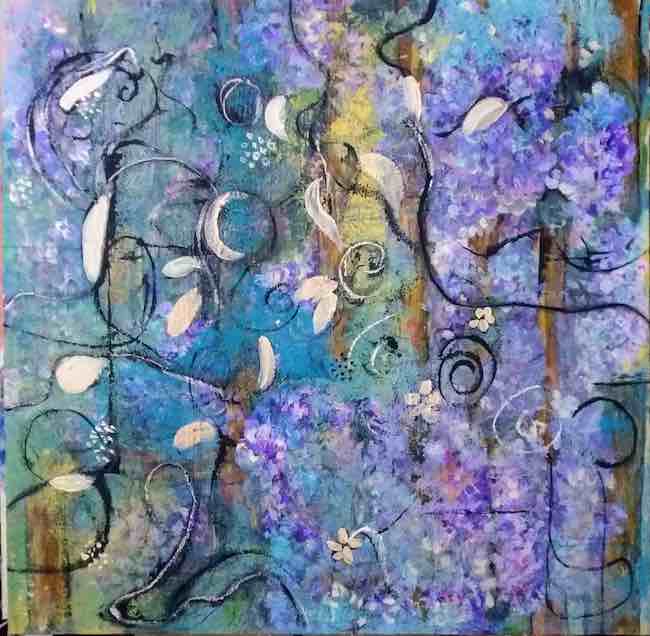
In Battiti d’ali l’artista stilizza e idealizza il mondo delle farfalle, simbolo di libertà e di rinascita, di capacità di uscire dal bozzolo mostrando tutta la loro delicata bellezza, trasformandole così in esortazione all’osservatore a lasciarsi trasportare dalla possibilità di liberarsi dal proprio di bozzolo, inteso come zavorra del passato oppure come somma dei limiti imposti dall’esterno o dalle sue stesse paure, per effettuare quel volo libero verso i reali sogni, i veri desideri spesso inconfessati perché troppo irraggiungibili. La gamma cromatica della tela lascia predominare i toni del viola che è il colore che più di tutti si lega all’anima, all’interiorità e alla capacità di introspezione a cui segue sempre una nuova consapevolezza.
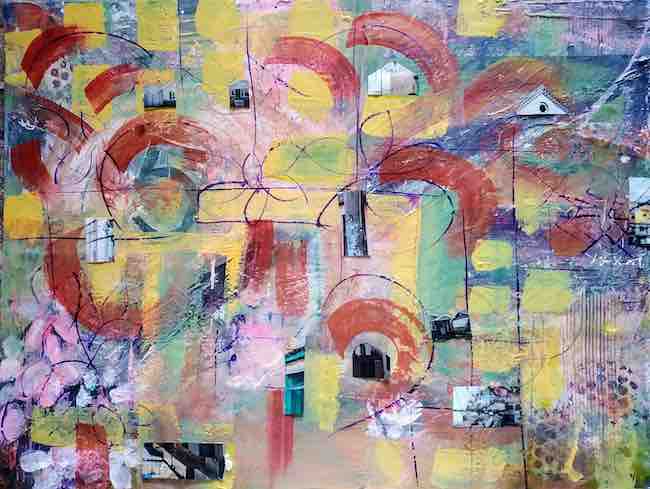
In Cuore di casa la Lodi sembra, ancora una volta, mettere su tela il suo legame con la semplicità, con le sensazioni più pure e naturali, quelle dell’amore per la famiglia, per il focolare domestico e per tutto quella gamma di emozioni che all’interno del focolare domestico si sprigiona. La sicurezza, il calore, il senso di protezione, la condivisione, vengono raccontate dall’artista con il colore rosa, più o meno sfumato, come se descrivesse un mondo ideale all’interno del quale tutto viene sostenuto, accettato e accolto solo in virtù della forza del sentimento che lega le persone; tuttavia a predominare sono i rossi, i gialli, i verdi che sembrano costituire le diversità che si amalgamano e si armonizzano malgrado ciascuno mantenga la propria spiccata personalità.
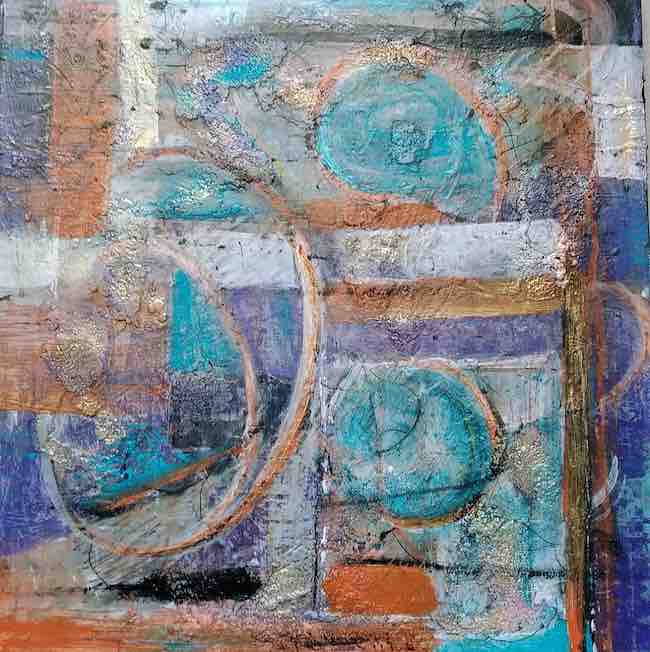
L’opera Intenzioni, su cui Laura Lodi sperimenta l’elemento materico, costituisce un suggerimento, quello di passare all’azione dando concretezza ai pensieri o ai desideri, fondamentale per modificare la realtà in cui l’individuo si trova a vivere; non è sufficiente dire di volere qualcosa di bello, espresso con la foglia oro, e di piacevole per far sì che si verifichi bensì è necessario trasformare l’idea e il sogno in qualcosa di possibile, lavorando duro e dare un seguito a quella voce interiore che induce l’individuo a volere di più. L’intenzione evocata nel titolo è piacevole, bella, contraddistinta da tonalità tenui, il verde acqua, l’ocra, la foglia oro, che possono rimanere lontane e solo contemplative, oppure diventare più solide e raggiungibili, come la materia in rilievo, se solo si ha il coraggio di intraprendere quei passi necessari per andare verso la concretezza.
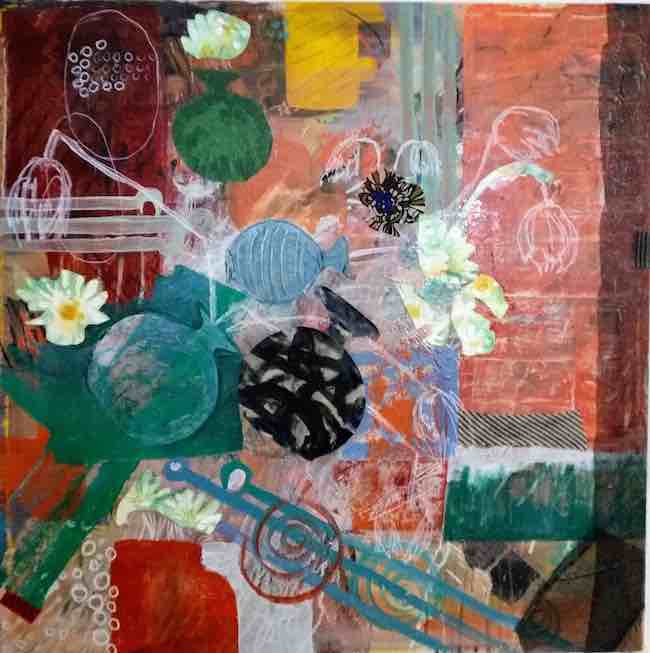
La tela Natura morta danzante assume caratteristiche più figurative, più vicine all’Espressionismo sognante di Marc Chagall ed Henri Matisse, entrambi sognatori e creatori di scene di fantasia pur senza mai essere staccati dalla realtà che si legava alla quotidianità; gli oggetti vagano sulla tela di Laura Lodi in maniera disordinata, in completa assenza di prospettiva, disposti casualmente sull’opera e legati tra loro da una inconsueta armonia, come se il loro balletto silenzioso non potesse fare a meno di rendere tutti gli elementi necessari, imprescindibili, essenziali a dare il senso generale della composizione. Le anfore, i fiori, i vasi, la tovaglia sono fondamentali per l’equilibrio della tela, tanto quanto le tonalità giocate sui toni dei verdi, dei galli, dei rosso scuro che infondono nell’osservatore la sensazione di trovarsi all’interno di una casa dove la tradizione si fonde con il calore e l’accoglienza.
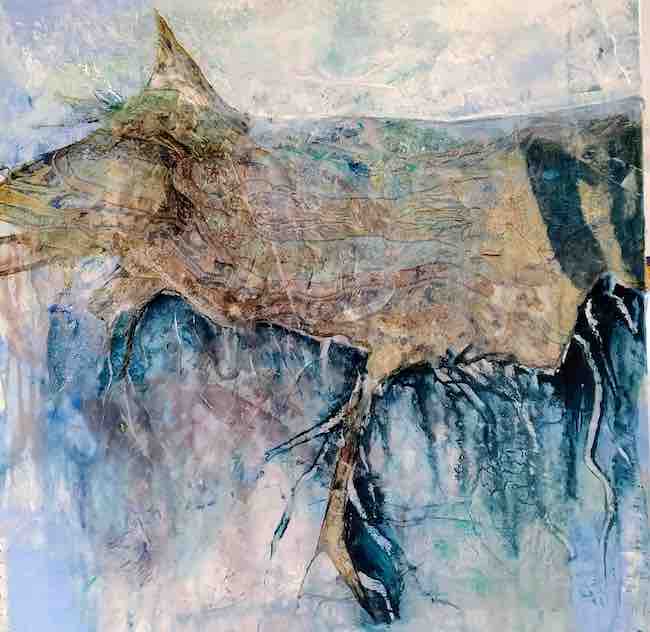
Laura Lodi ha frequentato il Liceo Artistico in Australia, paese dove ha vissuto a lungo, e poi ha proseguito il percorso nell’arte in Italia; ha al suo attivo la partecipazione a numerose mostre collettive a Sidney, Wollongong, Lugano e Bolzano che le sono valse molti riconoscimenti. È iscritta al Club Arcimboldo di Bolzano con cui espone regolarmente.
LAURA LODI-CONTATTI
Email: lauralodi48@gmail.com
Facebook: https://www.facebook.com/laura.lodi.75
Instagram: https://www.instagram.com/lora.lodi/
Laura Lodi’s chromatic digressions, recounting feelings about the reality that surrounds her
The world of emotions is an inescapable link between the interior, the profound feeling of artists as well as people, and the exterior, that knowable universe that inevitably interacts with the individual, sometimes enhancing their perceptions, at other times shifting the individual’s attention to those complexities, anxieties and anguishes that belong to contemporary living. Obviously, the pictorial and chromatic approach adapts to the expressive nature of the executor of the artwork, revealing his outlook on life and his observational and interpretative inclination on everything that revolves around him. The artist I am going to tell you about today shows a positive and open personality towards the more harmonious and pleasant side of reality.
The world of emotions was for a long time excluded from artistic expression, since the work of art had to disregard the subjectivity of the author and represent as faithfully as possible what was caught by the eye, in the case of Realism, which characterised much of the 19th century, or to narrate the aesthetic balance through the luminosity and vividness of colours, in the case of Impressionism, and then, a few years later, the rise of Abstractionism emphasised the supremacy of art over any reference to the observed or the artist’s feelings. And yet, other movements at the turn of the 19th and early 20th century strongly imposed the need to let emotions or reflections on the essence of life flow, placing the subjectivity of the artist and the human being at the centre of pictorial research; Expressionism on the one hand, and Surrealism on the other, were distinguished precisely by the characteristic of narrating, representing, the weaknesses, anxieties and emotions of man at the time, a complex period in which the winds of war eliminated all certainties, highlighting the ephemeral nature of life itself. In order to intensify and give greater prominence to the emotional world, which at that point had to be detached from the known image in order to favour a greater openness and freedom in the manifestation of sensations, Jackson Pollock founded a current in the United States around the 1950s that took the name of Abstract Expressionism, in which abstractist themes were merged, i.e. the rejection of the observed because it was distracting to the purity and immediacy of emotions, and expressionist themes where the inner world had to be prioritised over any rules of execution, favouring disharmony and chromatic unreality so that the works could highlight the inner universe of the artists adhering to the movement.
In Abstract Expressionism, the only guideline was expressive freedom aimed at letting out feelings that were sometimes more rushing and impetuous, typical of Dripping and Pollock’s Action Painting, others more meditative and evocative, as in Mark Rothko’s and Helen Frankenthaler’s Colour Field, or more minimalist, as in Franz Kline’s and Robert Motherwell’s sign painting or Ad Reinhard’s almost total monochrome. The Bolzano artist Laura Lodi, after a long journey within figurative art, decided to approach Abstract Expressionism, in some ways placing herself as a link to the Lyrical Abstractionism founded by Vassily Kandinsky because her artworks always reveal a melodic approach, harmonic, predisposed to listening to all those energies that escape from the reality that surrounds her and that by virtue of the artist’s sensitivity manage to find manifestation, a channel of listening and interpretation that reaches the observer in a delicate yet clear manner. What is striking about Lodi’s canvases, as well as the ever-present graphic sign that defines them and emphasises their message, is the chromatic range that is always vital, positive, oriented towards observing the beautiful and pleasant side of life around her, the harmony that can only be perceived through an open and smiling attitude to everything that happens and occurs, as if the artist were aware that it is by turning her gaze towards the simplicity and immediacy of feeling that the best of happenings can be taken, of natural reflections that materialise in undefined yet light-filled images. Because in the end, Lodi seems to suggest, it is not necessary to cling to what the eye knows in order to allow oneself to be enveloped by the resulting sensations, which can be described in a more intense and involving manner precisely by virtue of an expressive chaos that through the choice of colours arrives at a communicative order.
The tones chosen are either delicate or more intense but always played on the tones of the soul, the pinks, or of imagination and dreams, the blues, or even more varied but aimed at infusing the observer with a melodic sense, as if an imaginary music were an integral part of the canvas and emotions were taken by the hand to be led inside Laura Lodi’s dreamy world. In beats of wings, the artist stylises and idealises the world of butterflies, symbols of freedom and rebirth, of the ability to come out of the cocoon showing all their delicate beauty, thus transforming them into an exhortation to the observer to let himself be carried away by the possibility of freeing himself from his own cocoon, understood as ballast from the past or as the sum of the limits imposed by the outside or by his own fears, to make that free flight towards real dreams, real desires often unconfessed because they are too unattainable. The chromatic range of the canvas lets predominate the tones of violet, which is the colour that most of all ties in with the soul, interiority and the capacity for introspection, which is always followed by a new awareness. In Heart of the Home, Lodi seems, once again, to put on canvas her connection with simplicity, with the purest and most natural sensations, those of love for the family, for the domestic hearth and for all that range of emotions that are released within the domestic hearth. Safety, warmth, a sense of protection, sharing, are portrayed by the artist with the colour pink, more or less shaded, as if describing an ideal world within which everything is supported, accepted and welcomed only by virtue of the strength of the sentiment that binds people together; however, reds, yellows and greens predominate, seeming to constitute the diversities that amalgamate and harmonise despite each one maintaining its own distinct personality.
The artwork Intentions, on which Laura Lodi experiments with the material element, constitutes a suggestion, that of taking action by giving concrete form to thoughts or desires, fundamental for modifying the reality in which the individual finds himself living; it is not enough to say you want something beautiful, expressed with gold leaf, and pleasant to make it happen, but it is necessary to transform the idea and the dream into something possible, working hard and following up on that inner voice that induces the individual to want more. The intention evoked in the title is pleasant, beautiful, marked by soft tones, teal, ochre, gold leaf, which can remain distant and only contemplative, or become more solid and attainable, like the material in relief, if only one has the courage to take those necessary steps towards concreteness. The painting Dancing Still Life takes on more figurative characteristics, closer to the dreamy Expressionism of Marc Chagall and Henri Matisse, both dreamers and creators of fantasy scenes without ever being detached from the reality that bound them to everyday life; the objects wander on Laura Lodi’s canvas in a haphazard manner, in a complete absence of perspective, casually arranged on the work and bound together by an unusual harmony, as if their silent ballet could not help but make all the elements necessary, essential to give the overall sense of the composition. The amphorae, the flowers, the vases, the tablecloth are fundamental to the balance of the canvas, just as much as the tones played on in shades of green, cockerels and dark reds that instil in the observer the sensation of being inside a house where tradition merges with warmth and welcome. Laura Lodi attended Art School in Australia, where she lived for a long time, and then pursued her artistic career in Italy. She has participated in numerous group exhibitions in Sydney, Wollongong, Lugano and Bolzano, which have earned her many awards. She is a member of the Arcimboldo Club in Bolzano with which she exhibits regularly.


